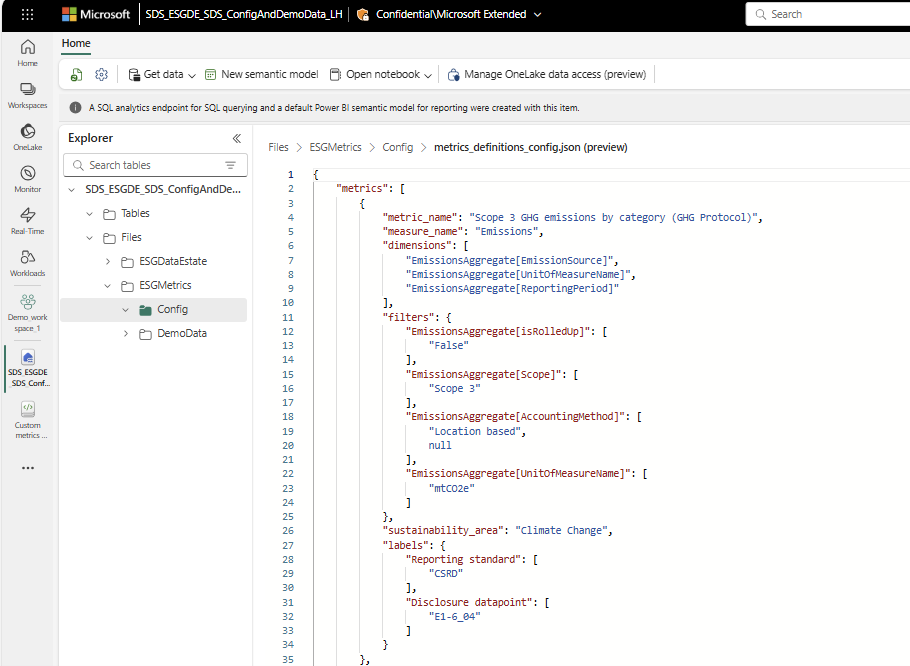Prebuilt Environmental, Social, and Governance metrics library
Important
Some or all of this functionality is available as part of a preview release. The content and the functionality are subject to change.
The Environmental, Social, and Governance metrics (preview) capability provides a library of prebuilt ESG metric definitions. The prebuilt definitions are deployed in the ConfigAndDemoData_LH as a JSON file (metrics_definitions_config.json) along with the ESG metrics capability deployment.
We currently support 61 prebuilt metric definitions across these European Sustainability Reporting Standards (ESRS):
- ESRS E1 Climate change
- ESRS E3 Water and marine resources
- ESRS E5 Resource use and circular economy
- ESRS S1 Own workforce
- ESRS 2 General disclosures
You can extend the metric definitions to create custom metric definitions using the provided utility functions. For more information, go to Custom metrics.
You can download a spreadsheet that describes each prebuilt metric here: Prebuilt metrics library.
Note
The prebuilt metric definitions are as per the EFRAG IG 3: Detailed ESRS Datapoints final document issued in May 2024 by EFRAG.
Here are the details of the metric definition properties specified in metrics_definitions_config.json:
metric_name: Name of the metric, such as Scope 3 category wise emissions (GHG protocol). This property is required.
sustainability_area: Categorizes the prebuilt metrics for the relevant ESG topics. It helps you to easily discover the metrics for a specific area. The sustainability areas align with Corporate Sustainability Reporting Directive (CSRD) standards. This property is required.
- Climate Change: Maps to ESRS E1 Climate change.
- Water and marine resources: Maps to ESRS E3 Water and marine resources.
- Resource use and circular economy: Maps to ESRS E5 Resource use and circular economy.
- Social: Maps to ESRS S1 Own workforce.
- General disclosures: Maps to ESRS 2 General disclosures.
measure_name: Specifies the name of the Power BI measure that contains the computation logic in Data Analysis Expressions (DAX) formula language. The Power BI measures are defined in the prebuilt semantic model deployed as part of the capability. For more information about Power BI measures, go to Create measures for data analysis in Power BI Desktop. This property is required.
dimensions: Specifies the dimensions/columns required in the metric output. These dimensions can come from aggregate tables and the calculated tables in semantic model.
filters: Specifies the values from the aggregate table dimensions that need to be filtered. This property is optional.
labels: Stores contextual information of a metric to help in discoverability. For example, mapping the metric to the disclosure standards and disclosure datapoints that require that metric’s output. This property is optional.
This image is an example of the metric definition from the metrics_definitions_config.json file.
To learn more about the metric computation logic, go to Generate and compute metrics data.

